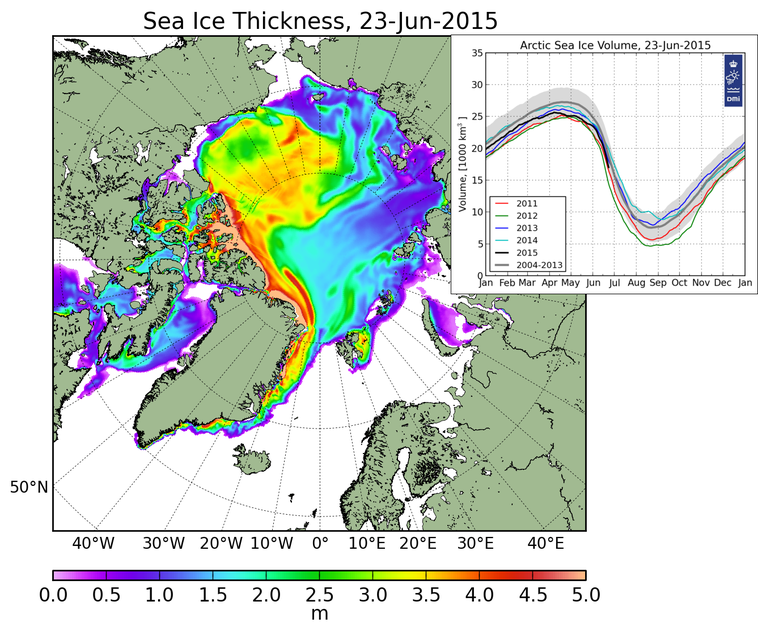Arctic sea ice thickness and volume on Polar Portal
Mads Hvid Ribergaard, Till A.S. Rasmussen, Kristine Madsen, Peter Langen, DMI
June 25th 2015
Since satellite monitoring began in the 1980s we have had a good handle on the areal extent of sea ice. This is important in a climate context due to the reflection of sunlight in the ice. The sea ice thickness is more difficult to determine but it has large impact on the stability of the ice. We now present the daily development of Artic sea ice thickness and volume since 2004 according to DMI’s ocean model system.
”Sea ice is a crucial parameter in climate research, particularly when focusing on the Arctic. This is because sea ice has a significantly brighter and more reflective surface than ocean water”, says oceanographer Mads Hvid Ribergaard from DMI. A large fraction of the incoming sunlight is thereby reflected when sea ice is present. Conversely, the solar energy will largely be absorbed in the ocean and heat it up if the ice is gone. This system reinforces itself and is termed the ice albedo feedback.
Since monitoring with satellites began in the early 1980s, we have been able to follow the areal extent of sea ice. We have thus observed that the summer extent has been generally decreasing with large year-to-year variations and some marked drops along the way. The sea ice thickness, on the other hand, is less well known since it is much more difficult to monitor from satellites. We do know, however, that Arctic sea ice today is thinner than in the 1980s and 1990s, but by how much and where is less certain.
Important for the stability of the ice cover
“The ice thickness is important to follow because it tells us about the robustness of the sea ice and whether it is thick enough to make through the summer melt. The thicker the ice, the more robust it is toward single warm summers”, explains Mads Hvid Ribergaard. Once the ice disappears, it is much harder for it to return and recover its original thickness due to the ice albedo effect.
Satellites and algorithms to determine sea ice thickness are being developed but they are still associated with large uncertainties, particularly for meter-thick ice. We therefore use DMI’s operational ocean and sea ice model system to give daily updates on the sea ice thickness and total volume. In addition, we show how this has developed since 2004.
Differences from year to year
In addition to the seasonal variation in the total sea ice volume, there are large variations from year to year. We note that the total ice volume does not always follow the ice extent. In the summer of 2007 we saw a very low extent which was a new record at the time. The following year, the extent increased a bit but the total ice volume was significantly lower than in 2007. The difference occurs because the ice was thinner in 2008 – likely as a result of the massive melting in 2007.
It is worth stressing that the above are modelled products which are associated with some uncertainty. It is difficult to determine which model system gives the most correct answer since there are very few direct measurements of sea ice thickness.
The total ice volume has risen since the record-minimum summer of 2012, which in itself is good for the health of the sea ice. The volume is, however, below the average for the first half of the 2000’s. “Although the ice is regaining some of its past stability and strength, it is not as well protected against warm summers as it used to be”, concludes Mads Hvid Ribergaard.
At the time of writing – around midsummer – the annual summer melt is well underway in the Arctic. On the Polar Portal you can follow the day-to-day developments of the sea ice thickness, distribution and total volume over the summer and see if the ice continues to hold out.
 |





